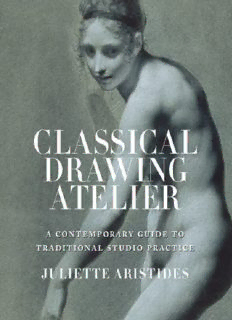
Classical Drawing Atelier: A Complete Course in Traditional Studio Practice PDF
Preview Classical Drawing Atelier: A Complete Course in Traditional Studio Practice
Randolph Melick, Study for Headless Man on Topless Bar, 2001, green wax-based pencil on paper, 11½ x 83⁄8 inches, courtesy of Hirschl & Adler Gallery Copyright ©2006 by Juliette Aristides First published in 2006 by WatsonGuptill Publications, an imprint of Crown Publishing Group, a division of Random House, Inc., New York www.crownpublishing.com www.watsonguptill.com Library of Congress Cataloging-in-Publication Data Aristides, Juliette. The classical drawing atelier : a contemporary guide to traditional studio practice / by Juliette Aristides. p. cm. Includes bibliographical references and index. eISBN: 978-0-82300837-7 1. Drawing—Technique. 1. Title. NC730.A68 2006 741.2—dc22 2006006985 Executive Editor: Candace Raney Editor: Alison Hagge Editorial Assistant: Maureen Lo Designer: Christopher Cannon and Eric Baker, Eric Baker Design Associates Production Manager: Ellen Greene Every effort has been made to trace the ownership of and to obtain permission to reproduce the material in this book. The author, editors, and publisher sincerely apologize for any inadvertent errors and will be happy to correct them in future editions. All rights reserved. v3.1 To Constantine Aristides Acknowledgments I would like to express my gratitude to all the people who helped make this book possible: thanks to Candace Raney for believing in the merits of this book before there was anything to see; and to Pamela Belyea and Gary Faigin, Director and Artistic Director respectively of the Gage Academy of Art, without whom this project would never have been started. I appreciate the amazing generosity of those who contributed work from private collections, especially Fred and Sherry Ross from Art Renewal Center, and Allan Kollar from A. J. Kollar Fine Paintings. Special thanks to Dino Aristides for your mathematical expertise applied in chapter two. Much gratitude goes to Al and Kathy Lopus for being the patron saints of art, in word and deed. I greatly appreciate gallery contributors: Ramon Frey from Frey Norris Gallery; Dr. Gregory Hedberg, Director of the Department of European Art at Hirschl & Adler Galleries; Steven Diamant, Director of Arcadia Gallery; and Nicola Lorenz from Forum Gallery. Thank you to all the models who spent many long hours posing and to the students, photographers, and professional artists who contributed such beautiful work to this book. Special thanks to D. Jeffrey Mims, who provided so much encouragement. Much appreciation goes to Mark D. Mitchell, Assistant Curator of Nineteenth-Century Art at the National Academy Museum. This project could not have been completed without the help of my editors. Many thanks to Sarah Campbell, Sarah Jardine, and Alison Hagge for your valuable insights. I am very grateful to design diva Susan Bari Price for your labor of love in providing tireless assistance on many aspects of this project. Thanks to Carol Hendricks, the Gage Academy resident art historian and friend, for your help with art historical references. Also many thanks to Roy Zuniga for all the Saturdays you spent designing the diagrams, done only for the love of art. Finally, deepest thanks to my teachers to whom I am forever grateful, especially Myron Barnstone, Carlos Madrid, Jacob Collins, and Steven Assael. Matthew Grabelsky, cast drawing of Orfeo Boselli’s San Benedetto, 2004, charcoal on paper, 24 × 14 inches, courtesy of the Angel Academy of Art CONTENTS Cover Title Page Copyright Dedication Acknowledgments Preface Introduction PART ONE: WELCOME TO THE ATELIER CHAPTER ONE: A HISTORICAL PERSPECTIVE Artistic Training in the Twenty-First Century PART TWO: TIMELESS PRINCIPLES CHAPTER TWO: DESIGN Nature and the Golden Ratio CHAPTER THREE: LINE Two-Dimensional Dynamics CHAPTER FOUR: VALUE The World in Black and White CHAPTER FIVE: FORM The Third Dimension PART THREE: TIMELESS SUBJECTS CHAPTER SIX: MASTER COPY DRAWING Learning from the Past CHAPTER SEVEN: CAST DRAWING Lessons from Master Sculptors CHAPTER EIGHT: FIGURE DRAWING Man as the Measure CHAPTER NINE: PORTRAIT DRAWING Window to the Soul PART FOUR: PUTTING THEORY INTO PRACTICE CHAPTER TEN: ATELIER DISCIPLINES Finite Principles, Infinite Applications LESSON ONE: SPHERE DRAWING LESSON TWO: MASTER COPY DRAWING LESSON THREE: CAST DRAWING LESSON FOUR: REDUCTIVE FIGURE DRAWING LESSON FIVE: PORTRAIT DRAWING Appendix Bibliography Index Edgar Degas, Study for the Semiramis, late nineteenth century, gouache on blue paper, with watercolor highlights, 113⁄8 x 85⁄8 inches, Louvre, Paris, France Photo Credit: Réunion des Musées Nationaux / Art Resource, NY
Description: